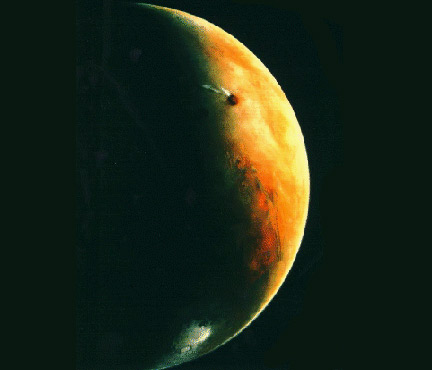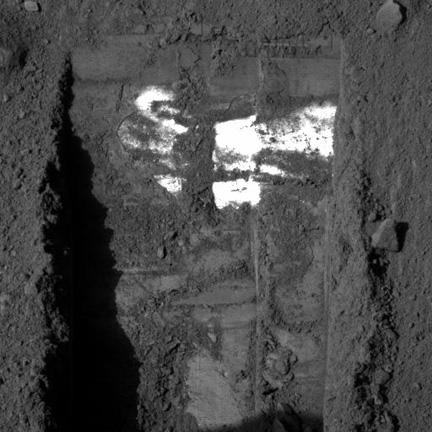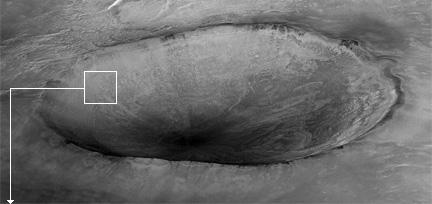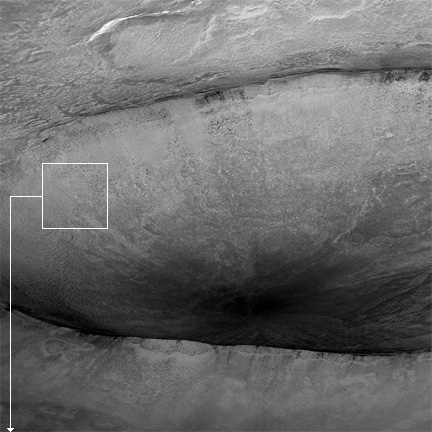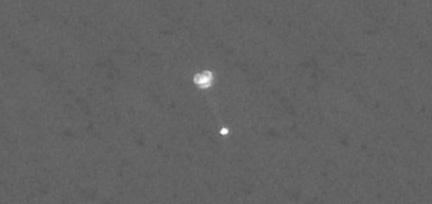 The Ganges Chasma is a side canyon at one end of the vast Valles Marineris trough system of Mars. This image was returned by ESA’s Mars Express, brought to our attention by Bill Dunford’s Riding with Robots. The image above is a 2560x1800 wallpaper. Download the 1440x900 here.
The Ganges Chasma is a side canyon at one end of the vast Valles Marineris trough system of Mars. This image was returned by ESA’s Mars Express, brought to our attention by Bill Dunford’s Riding with Robots. The image above is a 2560x1800 wallpaper. Download the 1440x900 here.
Phoenix’s Probable Last Surface Image
 On the Phoenix Mission’s 152nd Sol (a Martian day) the lander has fallen silent and mission engineers have been unable to communicate with it for over a week. This was expected as the Martian sunlight is less and less as the season changes. The sun is simply not providing enough energy to replenish its solar batteries. There is an outside chance that communications might resume again, but it would be a fleeting opportunity at best.
On the Phoenix Mission’s 152nd Sol (a Martian day) the lander has fallen silent and mission engineers have been unable to communicate with it for over a week. This was expected as the Martian sunlight is less and less as the season changes. The sun is simply not providing enough energy to replenish its solar batteries. There is an outside chance that communications might resume again, but it would be a fleeting opportunity at best.
In all, the mission prooved the existence of water-ice in the Martian subsurface; we saw (with our own eyes) Martian ice melting; it was the first time an atomic force microscope was used outside the bonds of Earth; the discovery that Martian soil may not be that different from the Earth’s and that growing plants in it may not be at all difficult; Phoenix found trace amounts of salt which could be nutrients for life; and finally calcium carbonate which suggests a past existence of liquid water on the surface of an anchient Mars.
And who could forget this image. Not too shabby.
Roving Mars
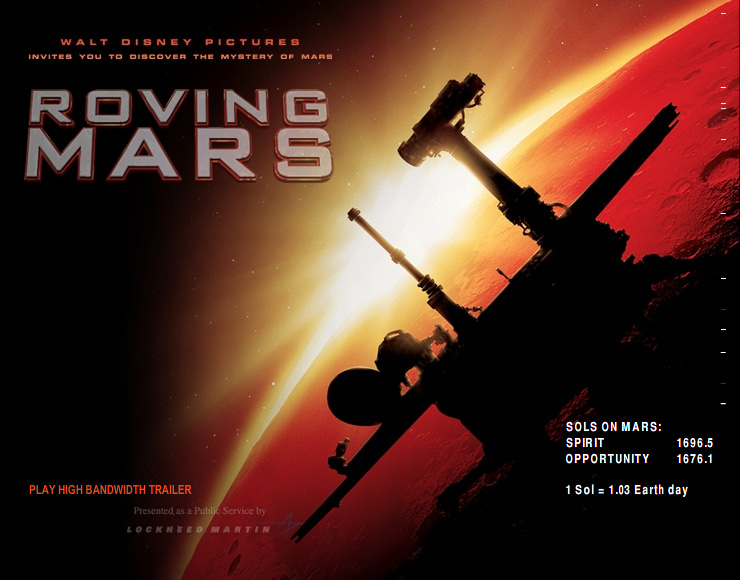 How do I not see these things? This was from back in 2006. I don’t recall ever hearing of this. It is an IMAX on the two Mars rover missions Spirit and Opportunity. Coincidentally, Paul Newman who passed recently apparently had something to do with it as well. I assume narration.
How do I not see these things? This was from back in 2006. I don’t recall ever hearing of this. It is an IMAX on the two Mars rover missions Spirit and Opportunity. Coincidentally, Paul Newman who passed recently apparently had something to do with it as well. I assume narration.
What We Can Do With Old Mission Photos
 These above images of Mars were composited by Emily Lakdawalla and display a staggering improvement over what we have seen published over and over again since the Viking missions took place in the mid-70’s (see below). You may be familiar with the bottom image as it is one of the few images of Mars taken in a crescent phase. I never would have guessed that by simply re-compiling the data with today’s everyday image software, it was possible to bring out the real beauty hidden within the data.
These above images of Mars were composited by Emily Lakdawalla and display a staggering improvement over what we have seen published over and over again since the Viking missions took place in the mid-70’s (see below). You may be familiar with the bottom image as it is one of the few images of Mars taken in a crescent phase. I never would have guessed that by simply re-compiling the data with today’s everyday image software, it was possible to bring out the real beauty hidden within the data.
Midnight Sun in Color
 “That’s my colourized version of the already-classic “Midnight Sun” image created by the Phoenix team, showing the path of the Sun across the sky as seen by the Phoenix lander. Up near the martian north pole Phoenix is in the martian Land of The Midnight Sun, and the Sun never sets, it just dips down towards and then rolls over the southern horizon at midnight before climbing up again…”
“That’s my colourized version of the already-classic “Midnight Sun” image created by the Phoenix team, showing the path of the Sun across the sky as seen by the Phoenix lander. Up near the martian north pole Phoenix is in the martian Land of The Midnight Sun, and the Sun never sets, it just dips down towards and then rolls over the southern horizon at midnight before climbing up again…”
Taken from phoenixpics.wordpress.com, a nice Phoenix fan site featuring the best images of the Phoenix mission thus far.
Color of Phoenix
 Don’t think we ever posted a true color of the Martian surface from the Phoenix mission yet. This was stitched together by James Canvin. Hopefully the next time we post this view it will be covered with Martian frost. Just in time for Christmas!
Don’t think we ever posted a true color of the Martian surface from the Phoenix mission yet. This was stitched together by James Canvin. Hopefully the next time we post this view it will be covered with Martian frost. Just in time for Christmas!
Argh
“Evidence of Soil Habitability Inconclusive.”
See The Planetary Blog on the results from Phoenix. Results could actually be the opposite of what we are hoping for…
Life Online
“Many people -- including, I must admit, me -- took this sentence to mean that a special briefing had taken place, alerting the White House to some positive news about life on Mars.”
Emily Lakdawalla comments on the Phoenix hub-bub which may have been over-blown.
Life On Mars
“It would appear that the US President has been briefed by Phoenix scientists about the discovery of something more "provocative" than the discovery of water existing on the Martian surface.”
Emily Lakdawalla of the Planetary Society will host a web stream on this matter Wednesday night.
Phoenix Lander from Mars Orbit
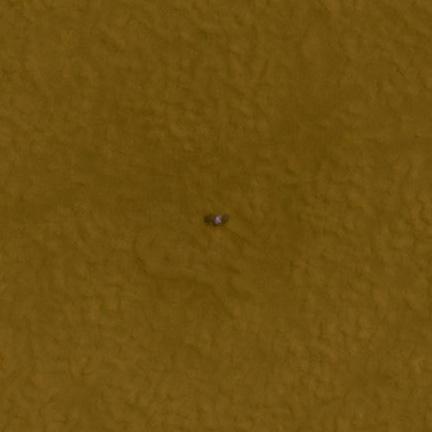 See the full story and larger surrounding area image here. Larger image includes the parachute, back shell and heat shield.
See the full story and larger surrounding area image here. Larger image includes the parachute, back shell and heat shield.
More Exposed Martian Ice
What is on Phoenix’s Leg?
 I cannot stop looking at this animation. The first frame was taken on the 8th sol (a Mars day) and the second around the 31st sol. As you can see from the animation, it seems that some mystery material is either growing, moving or multiplying around one of the legs of the Phoenix lander. The most likely source is frost building up on what would be a very cold surface, however the only issue is that it doesn’t look exactly like frost and it hasn’t appeared on any of the other legs.
I cannot stop looking at this animation. The first frame was taken on the 8th sol (a Mars day) and the second around the 31st sol. As you can see from the animation, it seems that some mystery material is either growing, moving or multiplying around one of the legs of the Phoenix lander. The most likely source is frost building up on what would be a very cold surface, however the only issue is that it doesn’t look exactly like frost and it hasn’t appeared on any of the other legs.
Image note: We added an artificial fade from 1 frame to frame 2 and scaled the original image to around 300%. Due to artifacts from increasing the scale and compression we added some noise to smooth out the overall appearance.
Martian Soil Could Support Life
 It looks like Phoenix is finding results with chemistry analysis tests that suggest Martian soil could - or could have supported life. We have known for a while now that elements like magnesium, sodium, potassium and chlorine are all found in Martian soil. Now we also know that the soil alkalinity is comparable to that which we grow all kinds of plants in here on Earth.
It looks like Phoenix is finding results with chemistry analysis tests that suggest Martian soil could - or could have supported life. We have known for a while now that elements like magnesium, sodium, potassium and chlorine are all found in Martian soil. Now we also know that the soil alkalinity is comparable to that which we grow all kinds of plants in here on Earth.
There are more tests to be done, but these results could make growing vegetables in Martian soil a reality one day. It also makes it more conceivable that some kind of life may one day have existed on Mars… or even currently.
The Phoenix Ice Melt
 Thank you… its just what we came for. Now, can we have that in a glass or perhaps with some bacteria?
Thank you… its just what we came for. Now, can we have that in a glass or perhaps with some bacteria?
Phobos Hangs Above the Martian Horizon
Was reminded of this image in the current issue of The Planetary Report. It was taken by Mars Express in 2007 and is featured in a current article about the excellent Russian Phobos-Grunt mission planned for 2009. This mission marks a return to planetary exploration for the Russian space program and does so in a big way. The plan is to land on the Martian moon Phobos – take samples of its surface and return them back to Earth. Sample return missions are technically very difficult and in all of history the number of attempts numbers in the single digits.
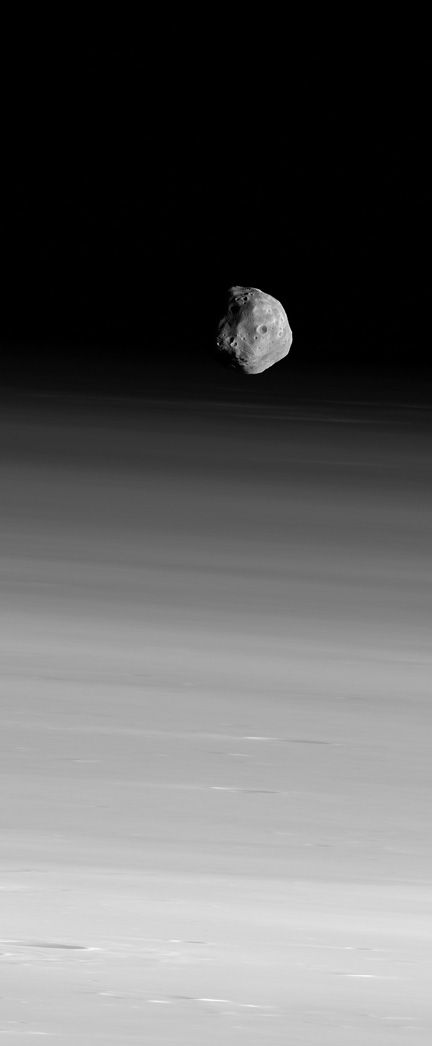
Pssst… Look Under Your Feet
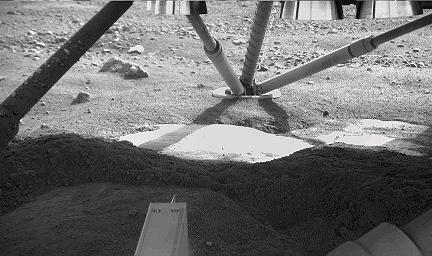 The Mars Phoenix Lander was sent on its long mission to Mars for really one purpose: to find ice. The region selected was seen as one of the more likely places on Mars to have an ice table that is closer to the surface and hopefully available to its robotic arm deployed just a few days ago.
The Mars Phoenix Lander was sent on its long mission to Mars for really one purpose: to find ice. The region selected was seen as one of the more likely places on Mars to have an ice table that is closer to the surface and hopefully available to its robotic arm deployed just a few days ago.
The above image was taken yesterday by that robotic arm and lead scientists suspect that the bright patch visible in the image is the very ice they have been looking for. It would seem that when Phoenix’s thrusters were fired to slow the lander down for a soft touch-down – that all the dust and soil below it was blown away to reveal a smooth and highly reflective surface.
It is not yet official… but this could mean mission accomplished for Phoenix.
Phoenix Landing Site as Seen by Mars Recon
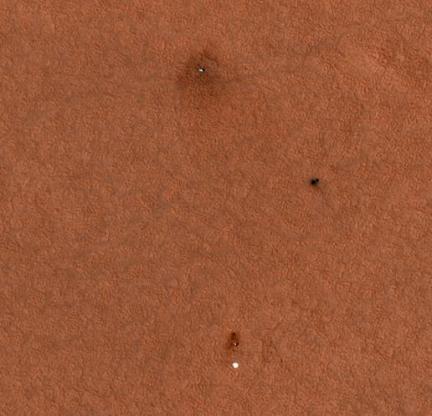 So much for descent images… here is Phoenix in its resting place also taken by Mars Recon. Seen here is the lander on top, the heat shield (with a bounce mark) and the parachute below (which appears to have fallen nicely elongated).
So much for descent images… here is Phoenix in its resting place also taken by Mars Recon. Seen here is the lander on top, the heat shield (with a bounce mark) and the parachute below (which appears to have fallen nicely elongated).
The Phoenix Landing Image in Context
Near True Color From Phoenix
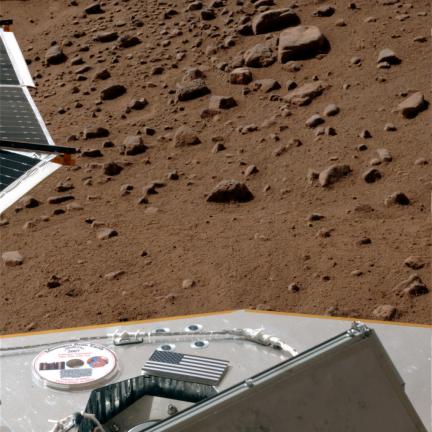 Near “true” color made by Gordan Ugarkovic using the only RED, GREEN and BLUE filtered images returned from the mission thus far. Additional adjustments were made by looking at the logo and the American flag (which we have an idea of what those color are supposed to look like) and adjusting the color of those items to appear as what we know are “true colors”. Logic then dictates that if those items are correctly balanced, then the Martian soil will also appear close to accurate.
Near “true” color made by Gordan Ugarkovic using the only RED, GREEN and BLUE filtered images returned from the mission thus far. Additional adjustments were made by looking at the logo and the American flag (which we have an idea of what those color are supposed to look like) and adjusting the color of those items to appear as what we know are “true colors”. Logic then dictates that if those items are correctly balanced, then the Martian soil will also appear close to accurate.
Phoenix Landing as Seen by Mars Recon
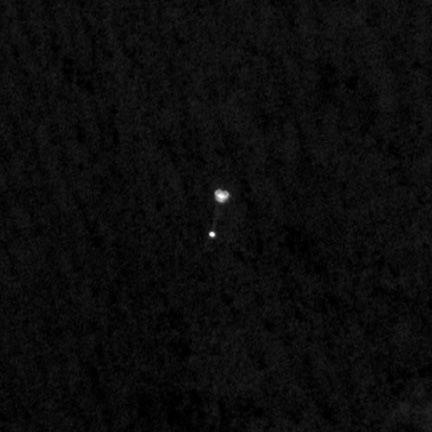 This image represents the very first time we have been able to acquire a visual on any kind of probe landing on the surface of another moon/planet. What is (clearly) seen here is the Mars Phoenix lander in the parachute phase of its descent. You can even make out the shape of the thin threads that hold Phoenix tethered to its chute.
This image represents the very first time we have been able to acquire a visual on any kind of probe landing on the surface of another moon/planet. What is (clearly) seen here is the Mars Phoenix lander in the parachute phase of its descent. You can even make out the shape of the thin threads that hold Phoenix tethered to its chute.
Normally a visit to another world is a solitary experience, but as many as 3 other probes already in orbit around Mars (Mars Reconnaissance, Mars Express and Mars Odyssey) were timed out to be in the general overhead vicinity of the Phoenix landing. It just so happens that one of them, Mars Recon, has very sharp eyes.
